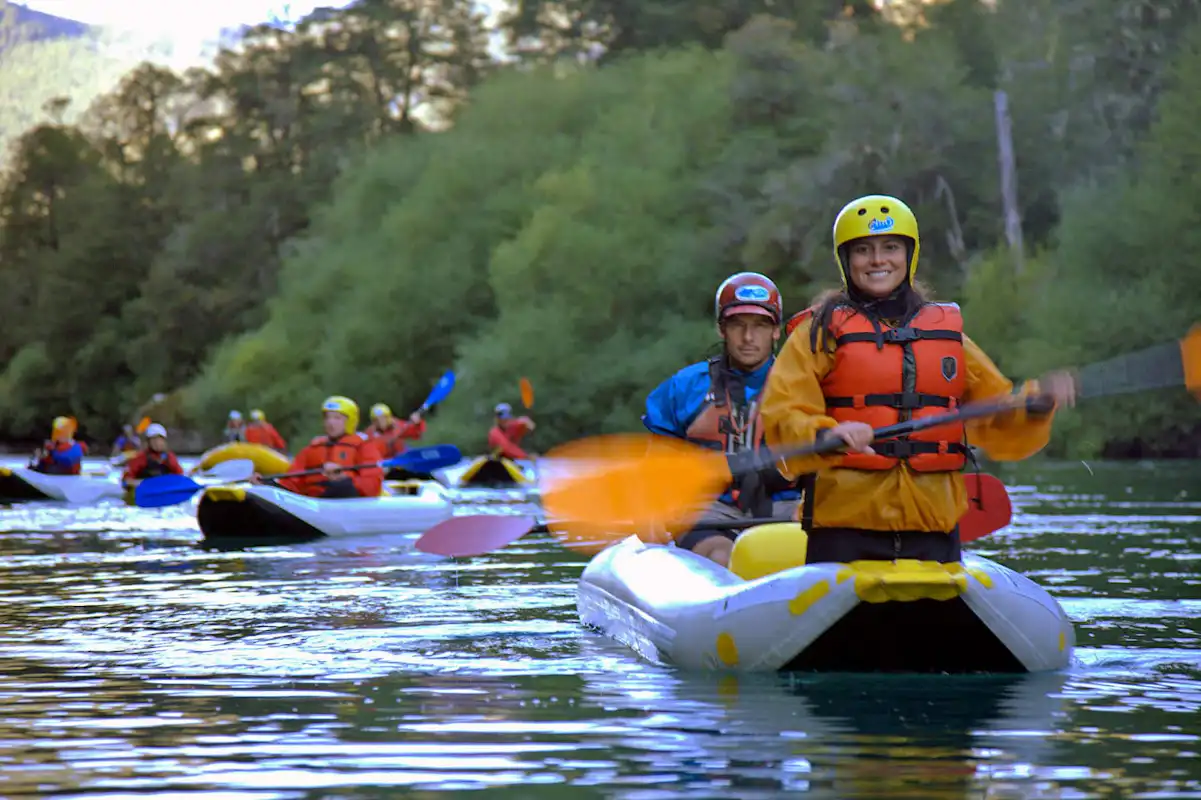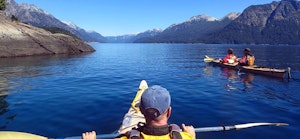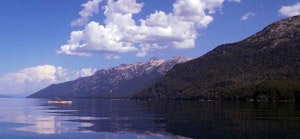With lakes thawing and snow melting in rushing cascades down the faces of the stunning Andes peaks, the Southern Hemisphere welcomes a vibrant hiking season where water sports also take the lead. Whether on an explorative canyoning program, a contemplative kayaking excursion, or an adrenaline-filled whitewater rafting adventure, a water sports trip is the perfect complement to the Patagonian summer and can combine well with other Andes trekking and mountaineering trips such as climbing Villarrica Volcano or climbing Lanín.
The Patagonia region in the southern end of South America, both on the Argentinean and Chilean sides, is home to some of the most stunning glaciers, rivers, lakes, mountains and islands of the continent. Many breathtaking national parks are located within this region and it is a top spot for adventure sports including rock climbing, hiking, mountaineering, and of course exciting water sports trips. Sparkling rivers, pure blue lakes, and even the sea are all waiting for you to dip in your paddle on an unforgettable outdoor adventure. Read on to find out everything you need to know about canyoning, kayaking, and rafting in Patagonia and start planning the best active holiday in South America to make your splash!
Canyoning, kayaking, and rafting: a brief overview
Canyoning
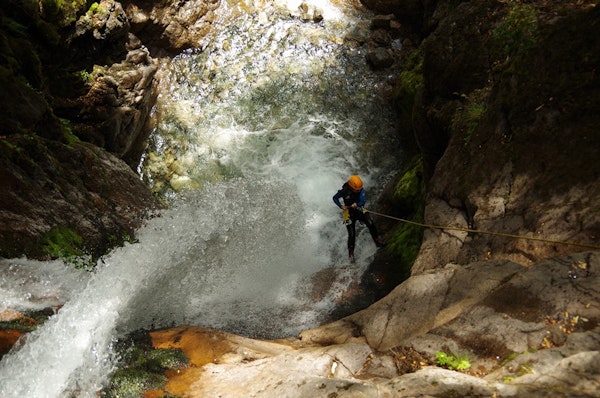 Patagonia water sports
Patagonia water sports
Canyoning, or canyoneering as it is also known, started out as an exploration sport using combined techniques to access remote canyons and gorges. This exciting outdoor adventure activity is both a water and a land sport as it combines rock climbing, hiking, swimming and/or abseiling. Jumping off small waterfalls, following streams and finding deep pools inside mysterious caves are all part of the thrill of canyoning. It is also a sport that can be practiced at all levels and is a great outdoor activity for kids. A certified guide will ensure that you acquire the necessary skills for your adventure, and will take all the necessary safety precautions too.
Equipment: Canyoning requires a lot of technical equipment for safety including canyoning shoes with excellent grip, wetsuit, helmet, ropes, a belay system, a harness, carabiner, and sling. Going with a professional guide frees you from having to handle the logistics involved in acquiring, renting or borrowing this equipment. Furthermore, guides know how to put the equipment to best use and will show you the proper techniques.
Would you like to learn more about canyoning? Read about equipment, best season and best places for Canyoning and find out everything you need to know to plan your adventure.
Kayaking
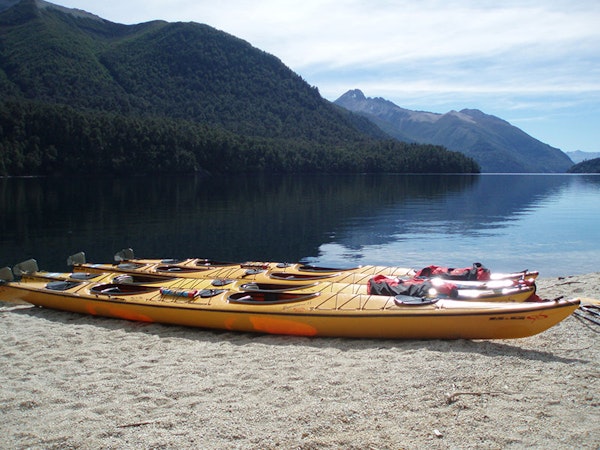 Patagonia water sports
Patagonia water sports
Kayaking is a fun water sport that involves paddling in a small boat that can fit one or two, sometimes more people. Because the boats are small, they are great to move through narrow waterways. Kayaking is also a fantastic complement for other combined outdoor activities such as hiking and camping. There are different variants of this sport, including recreational kayaking, which is more contemplative, sports kayaking, which involves kayaking in rapids and other testy situations, and sea kayaking, which tends to take place over the course of a few days and is more exploratory. There are kayaking options for all levels and all ages and it is overall a safe and very enjoyable outdoor adventure sport.
Equipment: Kayaking requires a kayak, a paddle, waterproof clothes or a neoprene suit, water-resistant shoes, a helmet, and a life jacket. Most guides include the kayak, paddle, neoprene suit and life jacket in their programs.
Read up on Kayaking and learn more about equipment, best season and top spots before organizing an unforgettable trip!
Rafting
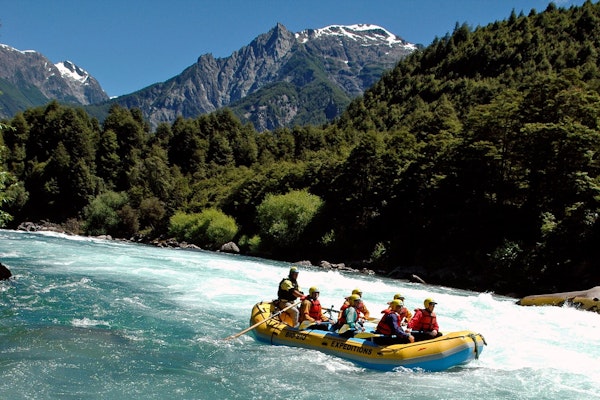 Patagonia water sports
Patagonia water sports
Rafting is a more intense water sport and involves using an inflatable raft, usually for groups of 6 to 10 participants, to explore rushing rivers. The types of river rapids are graded from I to VI according to the International Scale of River Difficulty. Class I, II, and III rapids are considered safe for basic level rafting and can be enjoyed by the whole family, while rapids graded class IV and onwards require more skills and can be dangerous, especially class VI.
Equipment: Rafting equipment includes the raft, paddles and oars, helmets, life jackets, and, in colder locations, neoprene suits. Most guides provide all the necessary rafting gear as part of their program.
Best places for Water Sports in Patagonia
ARGENTINA
Bariloche
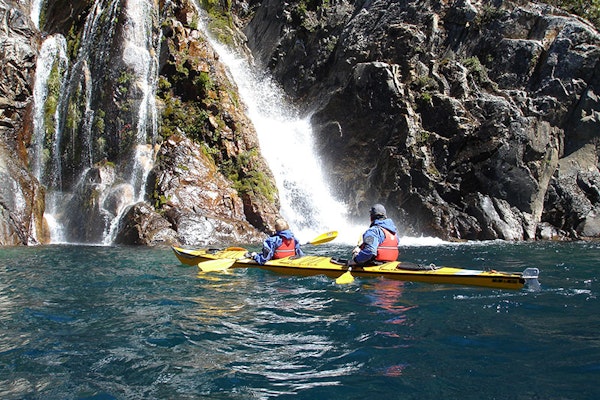 Patagonia water sports
Patagonia water sports
Located in the province of Río Negro in Argentina, and within Nahuel Huapí National Park, Bariloche is famous for its outdoor adventure options including canyoning, kayaking, and rafting.
A popular place for canyoning in Bariloche is the Arroyo López, which lies at the foot of Cerro López on the banks of the Moreno and Nahuel Huapí Lakes. Arroyo de la Virgen is another great spot for a canyoning adventure, especially if you are a beginner, and is on the way to Cerro Catedral.
Book your place now on an exciting canyoning adventure in Arroyo López or in Arroyo de la Virgen in Bariloche!
Kayaking is the most popular water sport in Bariloche, and there are plenty of options to explore the stunning blue lakes or to hike and paddle. You can combine a short kayaking program with a longer trekking excursion or find a combined program that will allow you to experience the best of both worlds.
Despite its name, which translates to "tame river", the feisty emerald-green Río Manso boasts grade III and IV rapids and breathtaking views of the Patagonian landscapes which makes it a top spot for rafting adventures.
Enjoy a beginner 1-day kayaking traverse in Bariloche, or join a long 3-day Nahuel Huapí Kayaking adventure! Looking for something a little longer? This 6-day hike and paddle adventure in the Andes could be a perfect fit.
In brief
Types of water sports: canyoning (beginner & intermediate), kayaking (all levels), rafting (grade III and IV rapids).
Climate: Temperatures in the summer months (between December and March) range between 20°C (68°F) and 25°C (77°F), the weather is sunny and dry. The water temperature in summer is between 8°C (46°F) to 12°C (53°F). In winter, temperatures may drop below zero and it is snowy. Water temperatures are between 2°C (35°F) and 4°C (39°F).
How to get to Bariloche: Fly to San Carlos de Bariloche International Airport, take a long-distance bus or drive.
El Bolsón
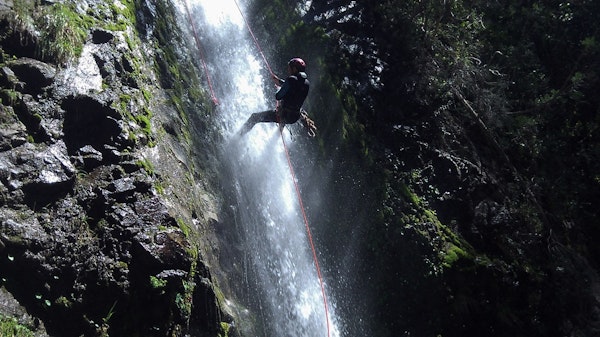 Patagonia Water sports
Patagonia Water sports
Also in the Río Negro province, at the base of Piltriquitron Mountain, El Bolsón is located further south than Bariloche. This beautiful Patagonian location is renowned for its pristine wilderness areas, artisan market, and unique outdoor adventure sports options. The famous Lago Puelo National Park is just 15 km south of El Bolsón, and is a beautiful spot for kayaking, as is the breathtaking and remote Epuyen Lake.
Some top spots for canyoning in El Bolsón include El Cravión for beginners, La Buitrera which is more technical and will require you to have prior canyoning skills, and the remote and idyllic Cajón del Azul, a deep and dark canyon for expert canyoneers that you can only enter walking.
Enjoy a beginner 1-day Canyoning program in El Cravión, join an intermediate canyoning program in La Buitrera or, if you are more advanced, don't miss the chance to explore the breathtaking Cajón del Azul on a 2-day Canyoning program in El Bolsón.
As in Bariloche, the Manso river is popular for whitewater rafting adventures. Additionally, the short and breathtaking emerald green Azul river, which begins in El Bolsón and flows into Puelo lake, is also a rafting hotspot.
In brief:
Water sports options: canyoning, kayaking & rafting (all levels).
Climate: Average highs in the summer reach 20°C (68°F), average lows in the winter reach 2°C (35°F) with below 0 temperatures and snow. Water temperatures are around 12°C (53°F) in the summer, and 2°C (35°F) in the winter.
How to get to El Bolsón: Bariloche (BRC) and Esquel (EQS) are the closest airports. You can fly and take a bus from either, take a long-distance bus from another location in Argentina or Chile, or drive.
El Chaltén
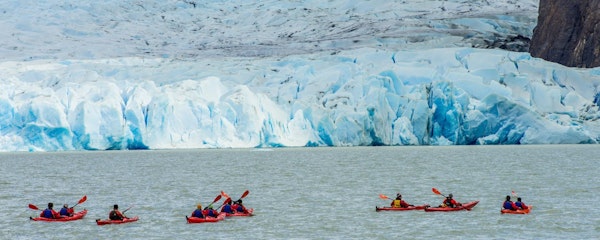 Patagonia Water Sports
Patagonia Water Sports
Located in Santa Cruz Province, El Chaltén is known as Argentina’s trekking capital and is set on the banks of the Río de las Vueltas, in the Los Glaciares National Park, where you can enjoy amazing rafting adventures. Additionally, two famous glacial lakes in the region are Laguna Torre and Laguna de Los Tres. El Chaltén is an ideal location for combined programs in which you can practice trekking, climbing, kayaking and more as you explore the breathtaking landscapes and terrains of the region.
Don't miss the chance to explore some of the most beautiful locations in the Andes on a combined 10-day program in Torres del Paine and El Chaltén!
In brief:
Water sports options: Canyoning, kayaking & rafting.
Climate: Average summer highs are 18°C (64.4°F), average winter lows are −1.2°C (29.8°F). Water temperatures are cold and range between 4°C (39°F**)** to 6°C (42°F).
How to get to El Chaltén: The most popular way to get there is to fly to Calafate, and from there you can take a 3-hour bus or drive. There are also direct long-distance bus options from other points in Argentina
Tierra del Fuego
 Patagonia Water Sports
Patagonia Water Sports
Way down south at the tip of the continent is the breathtaking Tierra del Fuego. The cold and mesmerizing archipelago is popular for trekking adventures and glacier hiking. Although canyoning and rafting are not popular options in Tierra del Fuego, it is a unique location for kayaking and also a sailing hotspot, as well as a starting point for expeditions to Antarctica.
The native Yamanas were famous for their canoes in which they traveled around the shores of Ushuaia and Cape Horn, settling in different places. Therefore, a kayaking adventure in this southernmost spot is truly unique as it is also a way of learning about the fascinating nomadic culture of the indigenous people that inhabited the islands for more than 10,000 years.
Join a unique 3-day sea kayaking adventure in the Beagle Channel and revel at the nature and culture of the southernmost point of South America!
In brief:
Water sports options: Kayaking, canoeing & sailing
Climate: Temperatures don't usually go over 15 °C (59 °F) in the summer, and average 0 °C (32 °F) in winter. Rain showers are also common, and there is occasional snowfall in the summer months which boast very long daylight hours. Seawater temperatures can go as high as 9°C (48°F) in the summer.
How to get to Tierra del Fuego: Fly in to Ushuaia, or take a bus, ferry or cruise. Punta Arenas is a popular location to cross over from Chile.
CHILE
Torres del Paine National Park
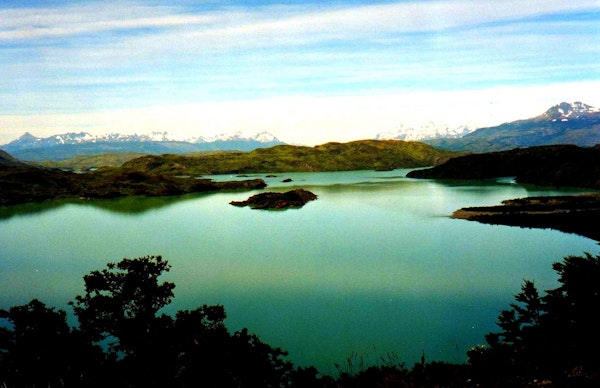 Patagonia water sports
Patagonia water sports
Located 112 km (70 mi) north of Puerto Natales and 312 km (194 mi) north of Punta Arenas, Torres del Paine is part of the End of the World Route (a Chilean scenic route in the south of the country) and an awe-inspiring location comprised of mountains, glaciers, lakes, and rivers. It is one of the most popular natural parks in Patagonia and a great spot for trekking and rock climbing, for rafting and kayaking, as well as for combined programs.
In brief:
Water sports options: rafting, kayaking, canyoning.
Climate: Average summer temperatures are 12°C (54°F) although they can go as low as 1°C (33°F), and as high as 23°C (75°F). Sub-zero temperatures are common in winter. Water temperatures are on average around 10°C (50°F) in the summer and 4°C (39°F) in the winter.
How to get to Torres del Paine: Fly in to Punta Arenas in Chile or to Calafate in Argentina. From there, take a bus to Puerto Natales, and then another bus to Torres del Paine, or drive.
Pucón
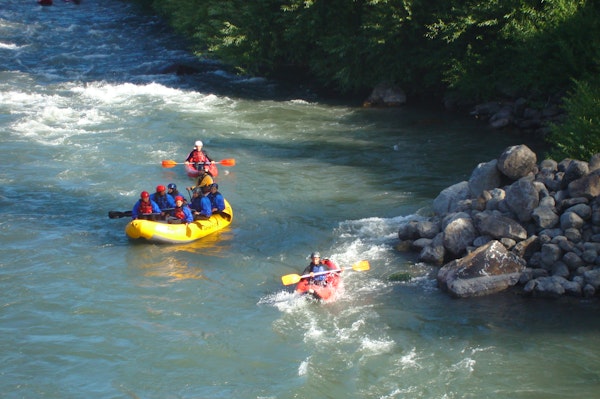 Patagonia water sports
Patagonia water sports
Located in Chile’s Lake District, Pucón is one of Chile’s top outdoor adventure destinations, and for good reason. At the foot of Villarrica Volcano, this breathtaking spot is a top choice for many mountaineers. Parque Nacional Huerquehue is a popular hiking spot, sprinkled with glittering lakes and Araucania trees. The rushing Trancura river is also fantastic for rafting and offers family-friendly options and more intensive grade III and grade IV rapids. Also, Correntoso Canyon is a superb spot for beginner canyoning while Pillán and Nevado Canyons are inviting locations for intermediate canyoning adventures. Pucón is also well-known for its hot springs.
Start out canyoning on an amazing 1-day program in Correntoso, or put your skills to test on a Pillán Canyon program or a Nevado Canyon trip near Pucón.
In brief:
Water sports options: Canyoning, kayaking, rafting.
Climate: Average summer temperatures are 24°C (75°F), average winter temperatures are 10 °C (50°F). Temperatures rarely drop below zero. Waters are usually warmer than other Patagonia locations, and it is a region with hot springs as well.
How to get to Pucón: In the summer, you can fly into Pucón's own small airport. Otherwise, Aeropuerto de la Araucania in Temuco is your best bet, and you can take a shuttle to Pucón from there.
Futaleufú
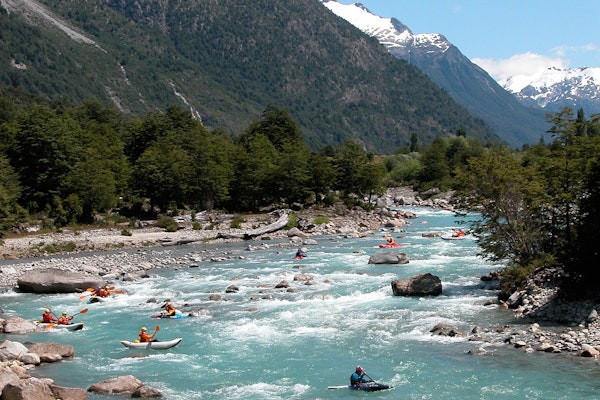 Patagonia water sports
Patagonia water sports
Located in the Los Lagos region, in Chile’s Palena Province, Futeleufú is Chile’s most popular whitewater rafting destination. In fact, Futaleufú River is considered to be one of the best rivers in the world for kayaking and rafting. Fuatelufú Valley is a wonderful location for canyoning and rappelling and Lake Espolón and Lake Lonconao are also popular spots for water sports. The Futaleufú National Reserve and Pumalín Park are also located in Futaleufú and are great for top outdoor adventure spots.
Join an easy half-day Futaleufú rafting program or an intermediate full-day whitewater adventure!
Looking for something a little more challenging? Then this unique 9-day Futaleufú rafting adventure should be to your taste!
In brief:
Water sports options: all, but especially rafting (with rapids from grade I to VI).
Climate: Summer temperatures range around 20 °C (68 °F) and it tends to be dry, winter averages are around 3.6 °C (38.5 °F) with a lot of precipitation and some snow. The Futaleufú waters are on the sunny side of the Andes and are typically quite warm for Patagonia.
How to get to Futaleufu: You can fly to Puerto Montt and then take a charter plane or bus from there to Futaleufú.
Don’t miss the chance to enjoy an unforgettable Patagonia water sports adventure. Whether it's a leisurely paddle on a lake, a deep exploration of a gorge, or a whitewater thrill you chase, you will find the perfect program to suit your preferences at Explore-Share.com!
